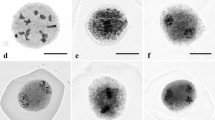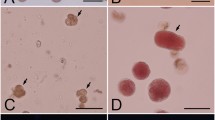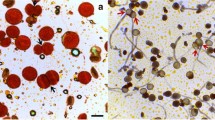Abstract
To reveal the mechanism of low triploid production, meiotic observation, induction of 2n pollen by colchicine, hybridization of colchicine-induced 2n pollen and pollen germination were conducted in Populus tomentosa clone 5088. Meiosis of the PMCs was initiated 24 h after it was cultured in the greenhouse. Results showed that the meiosis developed in a consecutive, asynchronous process. Analysis of the occurrence rate of colchicine-induced 2n pollen using the GLM-univariate revealed significant differences among the dominant meiotic stages (F = 45.822, P = 0.000). Significant differences also occurred among various colchicine injection times (F = 10.150, P = 0.004). The most effective stage for colchicine-induced 2n pollen occurred between the zygotene to diakinesis substages. Sixty-eight triploids were confirmed with both flow cytometric analysis and chromosome number-counting among the 3346 offspring. The highest triploid induction rate was 13.2%—significantly lower than the expected triploid production rate of 47.0%—indicating that the colchicine-induced 2n pollen was weak during fertilization. We found positive correlation between the efficiency of triploid production and the frequency of colchicine-induced 2n pollen (r = 0.961, P = 0.001) which suggests that the triploid production rate increased as the occurrence rate of colchicine-induced 2n pollen increased. Analysis using the GLM-univariate indicated that both pollen types (F = 87.50, P < 0.001) and durations of pollen germination (F = 7.61, P = 0.002) did have significant effects on the lengths of pollen-tubes. Haploid pollen-tubes were significantly longer than colchicine-induced 2n pollen-tubes. This suggests that haploid pollen has an advantage during fertilization.




Similar content being viewed by others
References
Bretagnolle F, Thompson JD (1995) Gametes with the somatic chromosome number: mechanisms of their formation and role in the evolution of autopolyploid plants. New Phytol 129:1–22. doi:10.1111/j.1469-8137.1995.tb03005.x
Galbraith DW, Harkins KR, Maddox JM, Ayres NM, Sharma DP, Firoozabady E (1983) Rapid flow cytometric analysis of the cell cycle in intact plants tissue. Science 220:1049–1051. doi:10.1126/science.220.4601.1049
Kang XY (2002) Mechanism of 2n pollen occurring in Chinese white poplar. J Beijing For Univ 24(5/6):67–70
Kang XY, Zhu ZT, Lin HB (1999) Study on the effective treating period for pollen chromosome doubling of Populus tomentosa × P. bolleana. Sci Silva Sin 35(4):21–24
Kang XY, Zhu ZT, Zhang ZY (2000) Breeding of triploids by the reciprocal crossing of Populus alba × P. glandulosa and P. tomentosa × P. Bolleana. J Beijing For Univ 22(6):8–11
Li Y, Guo Q, Wang J, Tian J, Kang XY (2014) Colchicine-induced pollen chromosome doubling and its cytological effects in Populus alba L. J Nucl Agric Sci 28(5):749–756
Lu M, Zhang PD, Kang XY (2013) Induction of 2n female gametes in Populus adenopoda maxim by high temperature exposure during female gametophyte development. Breed Sci 63:96–103. doi:10.1270/jsbbs.63.96
Mashkina OS, Burdaeva LM, Belozerova MM, Vyunova LN (1989) Method of obtaining diploid pollen of woody species. Lesoved 1:19–25
Mendiburu AO, Peloquin SJ (1977) The significance of 2n gametes in potato breeding. Theor Appl Genet 49:53–61
Müntzing A (1936) The chromosomes of a grant Populus tremula. Hereditas 21:383–393
Nilsson-Ehle H (1936) Note regarding the gigas from of Populus tremula found in nature. Hereditas 21:372–382
van Buijtenen JP, Joranson PN, Einspahr DW (1958) Diploid versus triploid aspen as pulpwood sources with reference to growth, chemical, physical and pulping differences. Tappi 41:170–175
Veilleux RE (1985) Diploid and polyploid gametes in crop plants: mechanisms of formation and utilization in plant breeding. Plant Breed Rev 3:253–288
Wang J, Kang XY, Li DL, Jing YC, Zhang ZH (2006) Meiosis and chromosome behavior of pollen mother cell in Populus simonii Carr. × P. nigra L. Acta Bot Boreal 26(11):2231–2238
Wang J, Kang XY, Li DL, Chen HW, Zhang PD (2010) Induction of diploid eggs with colchicine during embryo sac development in Populus. Silvae Genet 59:40–48
Wang J, Li DL, Kang XY (2012) Induction of unreduced megaspores with high temperature during megasporogenesis in Populus. Ann For Sci 69:59–67. doi:10.1007/s13595-011-0152-5
Weisgerber H, Rau HM, Gartner EJ, Baumeister G, Kohnert H, Karner L (1980) 25 years of forest tree breeding in Hessen. Allg For 26:665–712
Xi XJ, Jiang XB, Li D, Guo LQ, Zhang JF, Wei ZZ, Li BL (2011) Induction of 2n pollen by colchicine in Populus × popularis and its triploids breeding. Silvae Genet 60(3–4):155–160
Zhang ZH, Kang XY (2010) Cytological characteristics of numerically unreduced pollen production in Populus tomentosa Carr. Euphytica 173:151–159. doi:10.1007/s10681-009-0051-0
Zhang PD, Kang XY (2013) Occurrence and cytological mechanism of numerically unreduced pollen in diploid Populus euphratica. Silvae Genet 62(6):285–291
Zhang S, Qi L, Chen C, Li X, Song W, Chen RY, Han SY (2004) A report of triploid Populus of the section Aigeiros. Silvae Genet 53:69–75
Zhang SG, Chen CB, Han SY, Li XL, Ren JZ, Zhou YQ, Song WQ, Chen RY, Qi LW (2005) Chromosome numbers of some Populus taxa from China. Acta Phytotaxon Sin 43:539–544
Zhang L, Wang J, Suo YJ, Kang XY (2010) Pollen chromosome doubling under high temperature in Populus alba. J Nucl Agric Sci 24(6):1158–1165
Zhu ZT, Lin HB, Kang XY (1995) Studies on allotriploid breeding of Populus tomentosa B301 clones. Sci Silva Sin 31:499–505
Zhu ZT (ed) (2006) Genetic improvement of Populus tomentosa. China For Press, Beijing
Acknowledgements
We thank EditorBar (www.editorbar.com) for its linguistic assistance during the preparation of this manuscript. We also thank Guan Country nursery of Shandong province for collecting the plant material. This research was financially supported by the National Natural Science Foundation of China (No. 31370659).
Author information
Authors and Affiliations
Contributions
CZ conducted the experiments and wrote the paper. MT help collect plant materials and carried out the experiments. YL conducted the experiments. PZ was responsible for designing experiments, collecting plant materials, analyzing the results and revising the paper. All authors read and approve the manuscript.
Corresponding author
Rights and permissions
About this article
Cite this article
Zhao, C., Tian, M., Li, Y. et al. Slow-growing pollen-tube of colchicine-induced 2n pollen responsible for low triploid production rate in Populus . Euphytica 213, 94 (2017). https://doi.org/10.1007/s10681-017-1881-9
Received:
Accepted:
Published:
DOI: https://doi.org/10.1007/s10681-017-1881-9




